prototype Notre Dame
Author: Stefan Feld
Publisher: Alea/Ravensburger
preview by

| x |
|
|
|
|
|
|
|
|
|
|
|
|
|
|
|
|
|
|
|
|
|
|
|
|
|
|
|
|
|
|
|
|
|
|
|
|
|
|
|
|
|
|
|
|
|
|
|
|
|
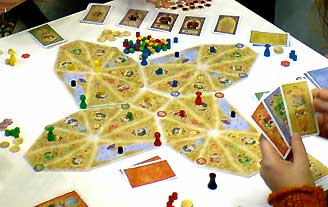 |
x |
Who or what we are in Notre Dame is less important, it's the victory points that count! These are scattered all over the board that consists of four player sections with a small central 'Notre Dame' square piece. The player sections all have seven quarters and a 'health track'. More points can be scored in one of the quarters, or by bribing certain characters. The earned points are collected and kept secret, so there is no exact knowing of how each player fares.
The game lasts three large rounds, each consisting of three smaller rounds in which each player has two turns where he plays one of initial three cards; the third card is discarded with the second card played. |
| xx |
|
|
|
|
|
|
|
|
|
|
|
|
|
|
|
|
|
|
|
|
|
|
|
|
|
|
|
|
|
|
|
|
|
|
|
|
|
|
|
|
|
|
|
|
|
|
|
|
|
| At the end of a small round all players may bribe one of three character cards with one gold; these characters are different each round. They bring goodies like extra victory points, or gold, or tokens, or a combination of these. After that, it is time for a health check: at the bottom of each character card are a varying amount of rats depicted. The numbers on the three cards are added, and all players adjust their health on the health track. If they exceed the '9', the rats have infected your quarter and you must lose one citizen, to be taken from the quarter with the most citizens. Furthermore, you lose two valuable victory points. Ofcourse each player has the possibility to influence his individual health, so each player fares differently on the health track. |
x |
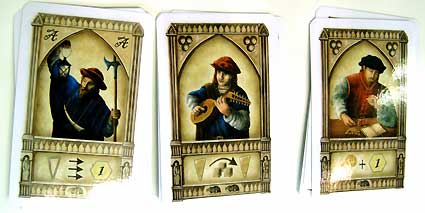 |
|
|
|
|
|
|
|
|
|
|
|
|
|
|
|
|
|
|
|
|
|
|
|
|
|
|
|
|
|
|
|
|
|
|
|
|
|
|
|
|
|
|
|
|
|
|
|
|
|
|
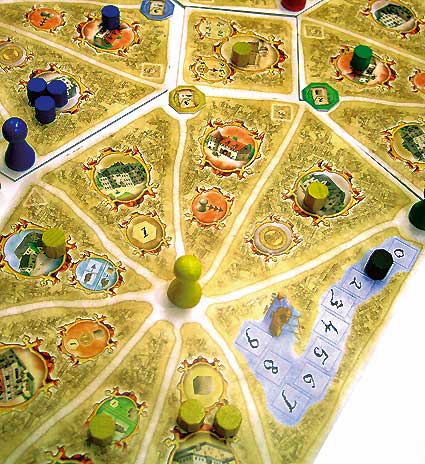 |
x |
So what do the player cards do then? And what about the quarters?
Each quarter depicts a different building that can be activated by playing the corresponding card and putting a citizen in it. Putting one citizen in the 'gold' quarter for instance instantly gives a player one gold. In a future round, by playing a card for this quarter, a player adds one more citizen, now has two in this quarter and may take two gold; three citizens give three gold, and so on.
The same goes for every other quarter: the first citizen brings a player one (victory point, movement, health, citizen), and every other brings him one more. Unfortunately, a player starts with only four citizens and some gold, so at one point he also wants to activate the 'citizen' quarter, to get one or more from the stock or, at the end of a round, bribe a character with one gold that earns a new citizen.
The sanatorium and the park work differently. For each citizen in the park, a player may go back one position on the health track - we all need some fresh air occasionally! - and for each pair of citizens a player gets an additional victory point each time he scores points from other sources. |
For each citizen in the sanatorium the health track marker also goes back one space; besides this it is checked at the end of a round when the effects of the rats influence a players health; a player may deduct one rat for every citizen in the sanatorium.
There is a player token that starts in the center of a quarter. This may be moved by activating the corresponding building; one junction for every citizen occupying the building. On most of these are chits that bring victory points, and an extra bonus such as one victory point, or a reduction of one rat on the health track. Players may only take an additional chit in their own colour for each set of all player colours that they have collected.
One card is for the central 'Notre Dame area, and it could earn up to 10 victory points, but only if a player is the only one in this area, as the 10 points are divided between all present citizens; placing more than one citizen per player is allowed to get a larger share or disencourage participation by other players.
A remark on how the building cards work: each player has his own set of cards. At the start of play he shuffles them and draws three at the start of a round. From these three, he picks one card that he wants to perform in this round, but gives the other two to his left hand neighbour. |
|
|
| x |
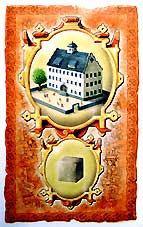 |
|
| Place a citizen from your supply in this quarter; for each citizen in this quarter you get a citizen from the stock. |
|
| x |
|
|
|
|
|
|
|
|
|
|
|
|
|
|
|
|
|
|
|
|
|
|
|
|
|
|
|
|
|
|
|
|
|
|
|
|
|
|
|
|
|
|
|
|
|
|
|
|
|
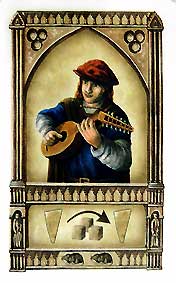 |
|
| Bribing this character with one gold enables you to move up to three citizens to another quarter. The card shows two rats that count against your health. More than one player may bribe the same character. |
|
x |
At the same time he gets two cards from his right hand neighbour from which he chooses one to keep and passes the other one to the left, at the same time getting one card from his right hand neighbour. So, a player starts the round with three different coloured cards with two card actions he gave away for the two players on his left. This can lead to very interesting decisions, especially if you see that a player on your left has no money or citizens to place, and you have a card for it, but in fact you want to take action from one of the other two cards, so in fact pass the money/citizen card.
There are no bonuses at game end, just the gathered points during gameplay that players count and reveal a winner.
The game can be played from 2 to 5 players and lasts about 75 to 90 minutes. Overall, the game plays very well, and gameplay feels like well fitting shoes: comfortable and conveniently leading you from A to B. Passing your own action cards to your left neighbour is a nice but known feature. Exceeding the '9' on the health track costs a player valuable victory points and one citizen from the most crowded district, so he has to be aware that he needs to do something on his health in one of the three rounds before the health is checked.
Maybe some elements of the game may not be overly original, fact is that it plays well and nice, and all players have a good time. This new Alea game will be more challenging than announced, and will attract dedicated gamers and the occasional ones alike. A game to look out for! |
| x |
|
|
|
|
|
|
|
|
|
|
|
|
|
|
|
|
|
|
|
|
|
|
|
|
|
|
|
|
|
|
|
|
|
|
|
|
|
|
|
|
|
|
|
|
|
|
|
|
|
| x |
|
|
|
|
|
|
|
|
|
|
|
|
|
|
|
|
|
|
|
|
|
|
|
|
|
|
|
|
|
|
|
|
|
|
|
|
|
|
|
|
|
|
|
|
|
|
|
|
|
 |
|
|
|
|
|
|
|
|
|
|
|
|
|
|
|
|
|
|
|
|
|
|
|
|
|
|
|
|
|
|
|
|
|
|
|
|
|
|
|
|
|
|
|
|
|
 |
|
|
|
|
|
|
|
|
|
|
|
|
|
|
|
|
|
|
|
|
|
|
|
|
|
|
|
|
|
|
|
|
|
|
|
|
|
|
|
|
|
|
|
|
|
| x |
|
|
|
|
|
|
|
|
|
|
|
|
|
|
|
|
|
|
|
|
|
|
|
|
|
|
|
|
|
|
|
|
|
|
|
|
|
|
|
|
|
|
|
|
|
|
|
|
|
 |
|
|
|
|
|
|
|
|
|
|
|
|
|
|
|
|
|
|
|
|
|
|
|
|
|
|
|
|
|
|
|
|
|
|
|
|
|
|
|
 |
|
|
|
|
|
|
|
|
|
|
|
|
|
|
|
|
|
|
|
|
|
|
|
|
|
|
|
|
|
|
|
|
|
|
|
|
|
|
|
|
|